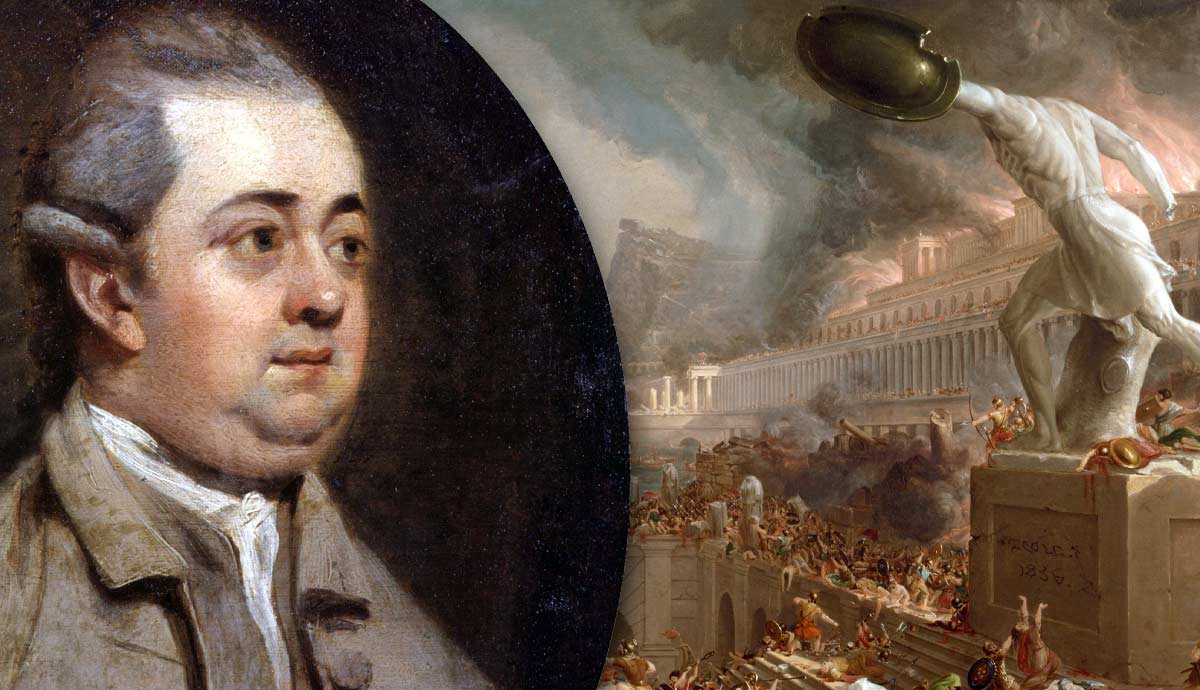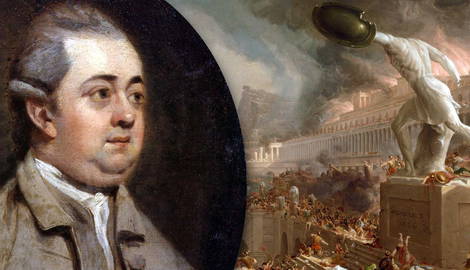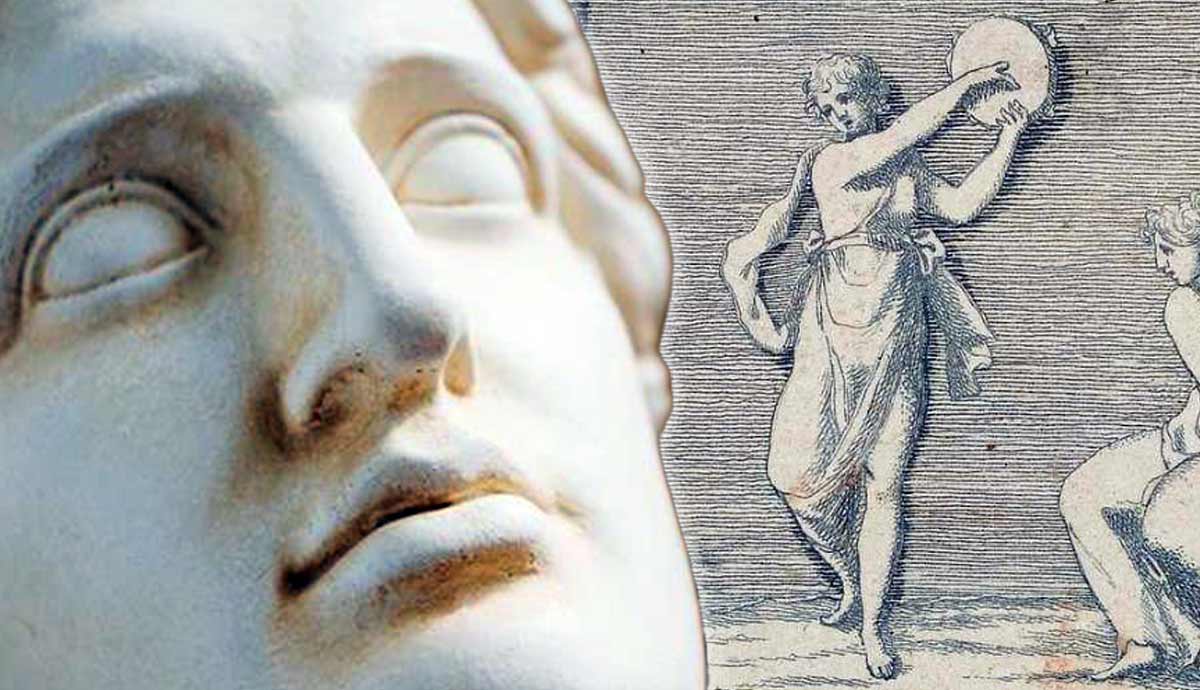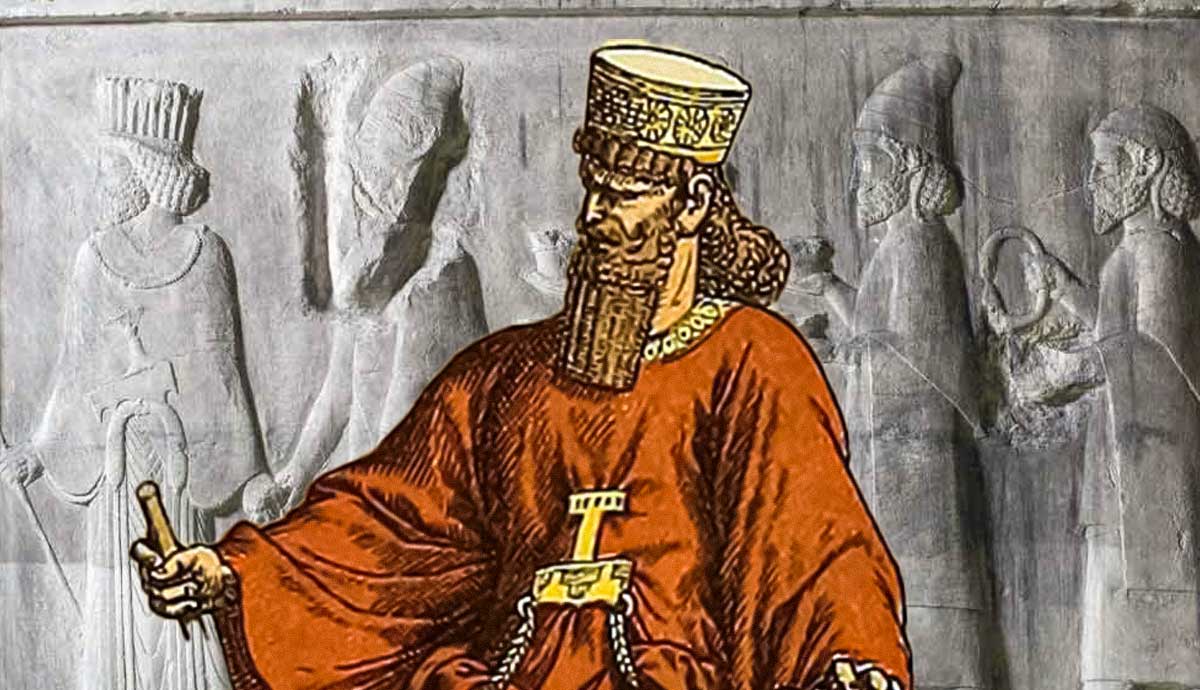
In the 18th century, Edward Gibbon wrote his six-volume magnum opus, The History of the Decline and Fall of the Roman Empire. It covers the history of the empire that started in the city of Rome from 98 CE to 1590 CE; over 3,928 pages. For generations, it was considered required reading for any serious student of Roman history, but is it still worth reading? This article introduces Gibbon, his context and influences, and provides a summary of what he covers in his tomes. It also reviews his arguments for what caused the decline and fall of Rome and what modern scholars think of his assessment.
Who Was Edward Gibbon?

Edward Gibbon was an 18th-century English historian famous for his enormous history of the Roman Empire. He is often credited with being the “first modern ancient historian” for his use of primary sources and criticism of organized religion, especially Christianity, in his evaluation of the past. He was also known for the quality of his prose, with witty irony for the entertainment of the reader. In this, he seems to have been influenced by the Roman author Tacitus, who was also known for his irony and focus on declining times.
However, critics also acknowledge that Gibbon was a writer “of his time.” He had minimal access to the modern archaeological evidence that has transformed our understanding of the past. He was also writing within the framework of 18th-century patriarchy, British imperialism, and the Enlightenment.
In some ways, Gibbon was a typical member of the English gentry at the time. Born into a wealthy family in 1737, he spent a year or so at Oxford when he was 15, which he reportedly did not enjoy, but he used the time to explore his passion for Roman history. As part of that passion, throughout his life, Gibbon acquired around 6,000 historical volumes, valued at £3,000, which is approximately £230,000 in today’s money.

In his early 20s, Gibbon was commissioned as a captain in the Seven Years’ War, serving in a home defense position in England. He still credited his service with giving him a better understanding of the Greek phalanx and the Roman legion. After his service, he headed off on the traditional “grand tour” of Europe, spending most of his time in Italy. As he traveled, Gibbon was greatly influenced by the philosophical ideas of the Enlightenment, which emphasized reason, progress, and individualism while challenging institutional beliefs, particularly those of the Church.
It was with this background that Gibbon returned to England and started writing, first an unpublished history of Switzerland, while juggling caring for his sick father and serving several terms in parliament. Gibbon reported that he started writing his magnum opus, The History of the Decline and Fall of the Roman Empire, in 1772. The first volume was published in 1776. Volumes II and III followed in 1781, and the final three volumes in 1788-1789.
Gibbon may have gone on to produce other interesting works if not for his poor health. He died in 1794 at just 56. He never married and had no children. However, in his youth, he fell in love with and proposed marriage to a Swiss pastor’s daughter, which was blocked both by Gibbon’s father and the girl’s unwillingness to leave Switzerland. The last years of his life were reportedly very lonely, without even his manuscript for company.
Timeline of Gibbon’s History

Gibbon’s history is often described as an analysis of what led to the decline and fall of the Roman Empire, but this is not an overly accurate characterization. He wrote a history of the world under the men who could call themselves Roman emperors, covering almost 1,500 years of history in 3,928 pages when it was originally published.
Gibbon started with what he believed to be the Golden Age of the Roman Empire under the Antonine Emperors. However, he also looked retrospectively as far back as Augustus, the first Roman Emperor. Gibbon was largely responsible for the characterization of the Antonine era as the height of the Roman Empire.
“If a man were called to fix the period in the history of the world, during which the condition of the human race was most happy and prosperous, he would, without hesitation, name that which elapsed from the death of Domitian to the accession of Commodus. The vast extent of the Roman Empire was governed by absolute power, under the guidance of virtue and wisdom…”
Gibbon covers the Roman Empire from Trajan (or Augustus) to the death of the last emperor of Rome, Romulus Augustulus, and this forms the bulk of his work, around half. But the Roman Empire was split into the Western Empire and the Eastern Empire in the late 3rd century CE, so his history also covers the centuries until the fall of Constantinople, then known as the center of the Byzantine Empire, at the end of the 15th century.

To cover the Byzantines, Gibbon must tell a much broader story of the empire’s surrounding pressures, including the rise of Islam, the crusades, and the Mongol threat. His work also covers the rise of Charlemagne as the Holy Roman Emperor in Western Europe. This was a title given to German monarchs who ruled over much of the old Western Empire, including parts of Italy. Charlemagne was made emperor by the pope on Christmas Day 800 CE, and his last successors abdicated in 1806 (so really, Gibbon’s history is a little short). This leads him to characterize Europe as entering a Dark Age and eventually emerging into the Renaissance. This is necessarily a simplified version of events, as he left himself so little space to cover this millennia.
Considering Gibbon’s history covers more than 1,000 years, from Britain in the west to Asia in the east, it is a stretch to refer to it as just one “Roman Empire.” It covers several different iterations and versions of empires that claimed to be the successors of the “original” Roman Empire.

In addition, Gibbon writes a broad history covering military tactics, religious revolution, artistic phases, and more. He does not just focus on what led to the decline and fall of these empires. But Gibbon chose this title for his work because he follows a paradigm of each empire reaching a peak in power and civilization and then entering what he sees as an almost inevitable decline.
“Prosperity ripened the principle of decay; the causes of destruction multiplied with the extent of conquest; and, as soon as time or accident had removed the artificial supports, the stupendous fabric yielded to the pressure of its own weight. The story of its ruin is simple and obvious; and, instead of inquiring why the Roman empire was destroyed, we should rather be surprised that it had subsisted so long.”
The Roman Empire in the West: Gibbon’s History

Nevertheless, embracing Gibbon’s selected title and the subject of the first half of his work, many commentators and critics focus on Gibbon’s analysis of the decline and fall of the empire centered on Rome. The city was sacked by Germanic tribes twice in the 5th century, and in 476 CE, the Germanic leader Odoacer deposed the last emperor in Rome, who was already little more than a figurehead. His insignia was sent to the emperor in Constantinople, and Odoacer became the first barbarian king of Italy. Gibbon covers this story in the first 36 of his 71 chapters.
Gibbon covers the rise of the Antonine Dynasty, commenting on the prosperity, military expansion, and artistic triumphs of this golden era (chapters 1-2). He does go back and look at the formation of the Roman Empire from the ashes of the Republic between Augustus and Domitian (chapter 3), before looking at the start of what he considered Rome’s downward spiral, starting with the follies and assassination of Commodus, the last of the Antonine emperors, which saw the Praetorian Guard selling the Empire to the highest bidder in the year of the five emperors (chapter 4-5).

After the Antonines, no later emperor lived up to their legacy. He covers the Severan Dynasty, which had already started to unravel following the death of its founder, Septimus Severus. His son Caracalla was a tyrant and committed fratricide. He was later usurped by Macrinus and replaced by the boy-princes of Syria, Elagabalus and Alexander Severus (chapter 6). This leads into the Third Century Crisis (chapters 7-12), including discussion of the empire’s crumbling borders with Parthia absorbed into the Sassanid Persian Empire (chapter 8) and uninterrupted barbarian raids of Germany (chapter 9).
Gibbon then turns to the rise of Diocletian and the formation of the Tetrarchy (chapter 13), which created senior and junior rulers for each half of the empire. Gibbon points to this decentralization of power as one of the major causes for the fall of Rome as he covers the resulting infighting and the rise of Constantine the Great (chapter 14).
This brings the rise of Christianity into the story of Rome (chapter 15), and Gibbon looks back on the persecution of Jews and Christians in the 1st century CE and the transformation of Christianity from a minor cult into a major religion (chapter 16). He looks at the foundation of Constantinople (chapter 17), Constantine’s successors (chapters 18-19), and rising Christian dogmatism with the formation of the Catholic Church (chapters 20-21).

Gibbon covers Julian the Apostate and the brief restoration of paganism (chapters 22-24) before covering the work of Jovian and Valentinian to hold together the army and the empire, plus new civil and ecclesiastical administration (chapter 25). He discusses threats from beyond Rome’s borders, such as the Huns and the Goths (chapter 26), and the chaotic power struggles within the empire (chapter 27), alongside the final fall of paganism, important religious figures such as St Ambrose, and the emergence of the cult of saints and relics within Christianity, which Gibbon criticizes in comparison to the “purer” faith of Islam (chapter 28).
Following what he calls the final division of the Roman Empire into east and west under the sons of Theodosius (chapter 29), he turns his attention to the long fall of the west with the revolt of the Goths, the plunder of Greece, the invasion of Italy, the Germans in Gaul, barbarians in Spain, Britain abandoned, and the Vandals in Africa (chapters 30-33). In the east, he covers Church politics and the rise of Attila the Hun (chapters 34-35). Finally, we reach the sack of Rome by the Vandals and the deposition of the last Roman emperor in the west (chapter 36).
Gibbon’s Causes: Decline and Fall of Rome

Within this dense and lengthy text, what are the main factors that Gibbon indicates led to the decline and fall of Rome and her empire in the west? There is no consensus on the complete list of causes given by Gibbon, as they are all embedded within his extended prose to be extracted by the reader, but there is general consensus from most commentators.
First, there are the external threats, which can be described as a continuous stream of invasions from the north and the east. These are either repulsed by the superior organization of the Roman Empire or victorious due to their warlike nature. Gibbon acknowledges and examines these threats but also suggests that if all these external enemies had been defeated, Rome still would have fallen.
Gibbon believes that even more damaging were the internal threats that existed within Roman society and administration. In Gibbon’s view, these causes are all interconnected and grow off one another. They start with the fall of the Antonines, when imperial power became dependent on military support over constitutional appointment. This made the army kingmakers with the power to extort the empire’s leadership. This resulted in repeated civil wars as generals vied for power with the support of their men, resulting in significant instability.

Supporting this army, essential both for political maneuvering and protecting Rome’s vast borders, was expensive. Taxes across the empire were high, and it is estimated that around 60% of revenue was spent on maintaining the army. With the empire relying on wealth from its provinces, every time territory was lost, it was a blow to the imperial coffers.
Alongside this, Gibbon points to a general moral decline in Roman society, which he relates to living under tyranny and Rome’s overall success. He said that this made the Roman populace comfortable, sacrificing power and responsibility for “bread and circuses” (leisure and increasingly brutal entertainments). He suggests that this made Roman society weak and “feminized,” removing the teeth of the Roman Army right when it needed them most.

Finally, Gibbon points to the adoption of Christianity, which Gibbon also suggests pacified the warlike Romans. He says that the best men who had previously led Rome’s armies now populated Rome’s monasteries, from where they preached a pacifist lifestyle but also fought among themselves about the minutiae of religious doctrine, resulting in more internal division.
“The clergy successfully preached the doctrines of patience and pusillanimity; the active virtues of society were discouraged; and the last remains of military spirit were buried in the cloister. A large portion of public and private wealth was consecrated to the specious demands of charity and devotion, and the soldiers’ pay was lavished on the useless multitudes of both sexes who could only plead the merits of abstinence and chastity. Faith, zeal, curiosity, and more earthly passions of malice and ambition kindled the flame of theological factions, whose conflicts were sometimes bloody and always implacable; the attention of the emperors was diverted from camps to synods; the Roman world was oppressed by a new species of tyranny, and the persecuted sects became the secret enemies of the country.”
Is Gibbon Still Valuable Today?

Gibbon wrote his History of the Decline and Fall of the Roman Empire almost 300 years ago, and scholarship has come a long way since then. So, do modern scholars agree with Gibbon’s assessment? Yes and no.
Scholars agree that the role the Roman army took as kingmakers greatly destabilized the Roman Empire, as anyone with sufficient military support could make a bid for power. It also made the army very expensive and difficult to control. In addition, the Roman Empire grew quickly and became too large to administer from Rome, requiring administrative divisions that strengthened some parts of the empire and weakened others. As a result, the Western Roman Empire could not stand up against the constant barbarian invasions and fell in the 5th century. The Eastern Empire was able to survive similar assaults because it was more economically stable and, therefore, had a stronger military.
Scholars disagree with Gibbon’s assessment of the culpability of Christianity. Anyone who knows their history would question calling Christian societies pacifist, and the same religious debates and cultural changes were active in the Eastern Empire and did not lead to collapse. Therefore, while modern scholars agree that Christianity certainly had a profound impact on Roman life, they argue that Gibbon overemphasizes its role in the decline and fall of Rome.
Despite this criticism, few new explanations for the decline of Rome have been suggested. Some scholars point to climate change affecting the region from around 150 CE onwards, leading to the Late Antique Ice Age and population migration. That could help explain why the barbarian invasions of the empire happened when they did.

Others suggest that the nature of the empire on the fringes of the tropics, with free movement of people over good roads and around the Mediterranean Sea, created the ideal conditions for the spread of pathogens, resulting in plagues that undermined life in the empire. We do hear of many deadly plagues, such as the Antonine Plague, greatly affecting Rome.
Yet others have pointed to widespread lead poisoning as a cause, since lead was used extensively in products used by the Romans, including their water pipes, and evidence of lead poisoning has been found in human remains.
While these are all potential factors to consider, none of them seem to supersede Gibbon’s overall assessment of how the empire became destabilized. Therefore, is Gibbon still worth reading? Many scholars will say yes, as he provides an entertaining tour of the ancient world with ubiquitous references to the primary sources we still rely on today. However, when interpreting Gibbon, we need to remember what he lacks, such as archaeological evidence, and remember the paradigms that influenced his interpretation, in particular, the rejection of Church authority and the philosophy of the Enlightenment.









